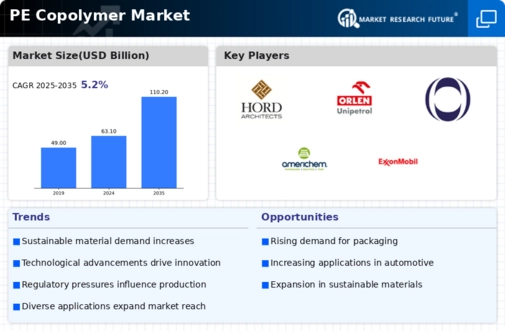Market Analysis
In-depth Analysis of PE Copolymer Market Industry Landscape
The market dynamics of the PE copolymer market are influenced by a variety of factors that impact its supply, demand, and pricing. PE copolymers, or polyethylene copolymers, are a type of thermoplastic resin derived from the polymerization of ethylene with other monomers, such as propylene or vinyl acetate. These copolymers find widespread use in industries such as packaging, automotive, construction, and healthcare. One of the primary drivers shaping the market dynamics is the increasing demand for PE copolymers in the packaging industry. PE copolymers are favored for their versatility, offering a balance of properties such as flexibility, toughness, and chemical resistance, making them ideal for applications such as flexible packaging films, bottles, and containers. As the global demand for packaged goods continues to grow, driven by factors such as population growth, urbanization, and changing consumer preferences, the demand for PE copolymers is expected to rise, driving market expansion.
Supply-side factors play a significant role in the market dynamics of PE copolymers. The production of PE copolymers involves specialized polymerization processes and requires access to raw materials such as ethylene and other comonomers. Therefore, factors such as the availability of raw materials, advancements in polymerization technologies, and the efficiency of production processes significantly impact production capacity and supply levels. Additionally, the presence of key manufacturers with established production facilities and distribution networks influences market dynamics, with expansions or disruptions affecting supply volumes and pricing.
Global trade patterns and regulatory frameworks contribute to the complexity of PE copolymer market dynamics. Many countries rely on imports to meet their demand for PE copolymers, leading to fluctuations in prices and supply chains. Trade policies, tariffs, and regulations regarding the import and export of plastics and chemical products influence market dynamics by affecting supply levels and pricing structures. Moreover, regulatory measures related to product safety, environmental standards, and recycling initiatives impact the production, distribution, and usage of PE copolymers, influencing market dynamics and pricing strategies.
The pricing dynamics of PE copolymers are influenced by various factors, including raw material costs, production costs, and market competition. Fluctuations in the prices of ethylene and other comonomers directly impact production costs, thereby influencing pricing dynamics. Energy prices and transportation costs also contribute to production expenses, affecting pricing strategies adopted by manufacturers. Market competition among suppliers and manufacturers further influences pricing dynamics, with companies adjusting their pricing strategies to gain market share or maintain profitability in a competitive landscape.
Demand-side factors, such as evolving consumer preferences and trends in end-user industries, shape the market dynamics of PE copolymers. In addition to the packaging industry, PE copolymers find applications in sectors such as automotive, construction, and healthcare. The demand for PE copolymers in these industries is influenced by factors such as technological advancements, product innovation, and regulatory requirements. Moreover, shifts in consumer preferences towards sustainable and recyclable materials drive demand for PE copolymers with enhanced environmental performance, impacting market dynamics and pricing strategies.
Market dynamics in the PE copolymer sector are also influenced by cyclical trends and seasonal variations. Certain industries, such as construction and automotive, experience fluctuations in demand for PE copolymers based on factors such as construction activity levels, automotive production cycles, and seasonal variations in consumer demand. Moreover, economic factors, global crises, and shifts in geopolitical dynamics can disrupt supply chains, affect consumer spending, and impact the overall demand for PE copolymers, leading to fluctuations in market dynamics and pricing structures.









Leave a Comment